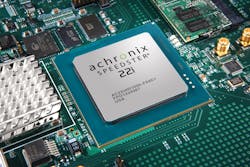Achronix Semiconductors revealed that its revenue had grown sevenfold over the last year and will surpass $100 million this year. And there are lessons in those figures.
The privately-held company is not required to report revenues but on Wednesday trotted out financial successes. The recent gains reflect the growing market for FPGAs and other chips that act like accelerators for tricky tasks like classifying images to autonomous driving.
As improvements in traditional CPUs have slowed, Nvidia has been leading the push into accelerators for servers and self-driving cars. Nvidia’s chief Jensen Huang has been an evangelist for its graphics chips, which can be used to train and execute machine learning code. Nvidia’s stock price tripled to $150 in the last year.
Achronix’s success shows that FPGAs remain in the conversation. Though difficult to reprogram precisely, the chips can do the same parallel processing as graphics chips. Nvidia’s are still the gold standard for training machine learning models, but cloud giants like Microsoft and Baidu are using FPGAs to apply those models to large amounts of data.
The competition for that business includes Xilinx and Intel, which last year acquired Altera for $16.7 billion. The world’s largest maker of server chips plans to package Altera’s FPGAs with CPUs in future products and later squeeze them onto the same silicon to increase computing power. Xilinx has been releasing software stacks to help cut down the complexity of FPGA design.
Achronix reads from a similar playbook. “[We] are entering a new high growth era where our customized core FPGA technology can accelerate a broad range of complex compute tasks in machine learning, artificial intelligence, software defined networks and 5G base stations,” said Robert Blake, Achronix’s chief, in a statement.
Its products include Speedster 22i FPGAs, which contain large amounts of SerDes and I/O to interface with a central processor using PCIe interconnects. The 22nm chips come with 86 megabits of embedded memory and support up to a million look-up tables, also known as LUTs, which are central to an FPGA's processing power.
Achronix’s revenue largely comes from its Speedster products, which first went into production in 2015 and will be refreshed in 2018. But the fabless supplier has increasingly split its business into new directions: Last year, it started licensing the intellectual property behind Speedster.
The blueprints, sold under the brand Speedcore, let engineers integrate 16nm FPGAs into custom system-on-chips, also known as SoCs. These embedded FPGAs are faster and more power efficient than standalone chips because they share the same silicon as computer processors and other circuitry, Achronix says.
With Speedcore, chip designers can change the number of LUTs as well as embedded memory and DSP blocks to suit specific applications. Before the end of the year, Achronix will allow customers to work with the next generation of Speedcore based on TSMC’s 7nm production process.
The moneymaking opportunity in embedded FPGAs is not a secret. Flex Logix, a newcomer run by the former chief executive of Rambus, has raised almost $14 million to sell its eFPGAs for networking hardware and data centers, and has recently won contracts with DARPA and Harvard. Last year, QuickLogic began licensing eFPGAs to be used in wearables and sensors.
Achronix’s victory lap came after years of defying investor apathy for the chip industry. The company had been running off $132 million in venture funding since its 2004 founding, But it finally hit profitability this year and plans to expand its 75-person staff by a third over the next six months.
About the Author
James Morra
Senior Editor
James Morra is the senior editor for Electronic Design, covering the semiconductor industry and new technology trends, with a focus on power electronics and power management. He also reports on the business behind electrical engineering, including the electronics supply chain. He joined Electronic Design in 2015 and is based in Chicago, Illinois.

